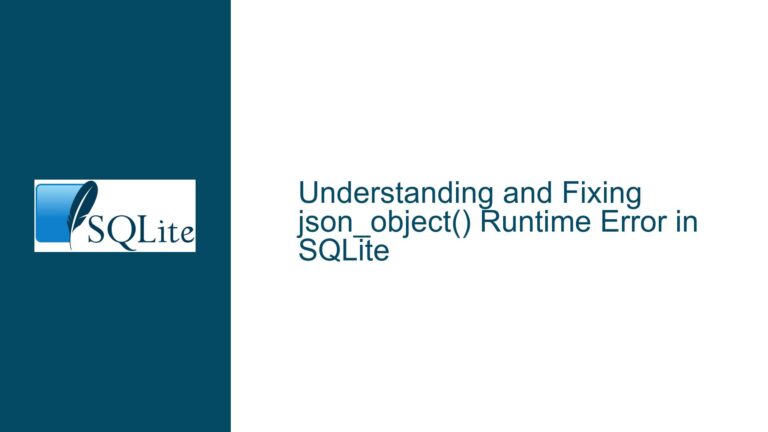Lock Contention in ForceLogPrepare During Concurrent SQLite Writes
Understanding Lock Contention in ForceLogPrepare During Concurrent Database Writes
Lock contention in the ForceLogPrepare method is a critical performance bottleneck when writing to multiple SQLite databases concurrently using the System.Data.SQLite library. This issue manifests as significant delays, with profiling indicating that approximately 30% of the execution time is spent waiting for locks within ForceLogPrepare. The ForceLogPrepare method is part of the SQLite library’s internal mechanisms for ensuring transactional integrity and consistency during write operations. When multiple threads or processes attempt to write to separate SQLite databases simultaneously, they may contend for the same lock, leading to performance degradation.
The ForceLogPrepare method is responsible for preparing the write-ahead log (WAL) for transactional commits. The WAL is a key component of SQLite’s concurrency model, allowing multiple readers and a single writer to operate concurrently without blocking each other. However, the lock contention in ForceLogPrepare suggests that the current implementation may not be fully optimized for high-concurrency scenarios, particularly when multiple databases are involved.
The issue is exacerbated when using the System.Data.SQLite library, which is a .NET wrapper for SQLite. The library introduces additional layers of abstraction and synchronization, which can further complicate the locking behavior. Profiling the code reveals that the lock in ForceLogPrepare is a significant bottleneck, but without the ability to build and test a modified version of the library, it is challenging to confirm whether the observed performance issues are due to the profiler’s overhead or inherent inefficiencies in the locking mechanism.
Potential Causes of Lock Contention in ForceLogPrepare
The lock contention in ForceLogPrepare can be attributed to several factors, ranging from the design of the SQLite library to the specific implementation details of the System.Data.SQLite wrapper. Understanding these causes is essential for identifying effective solutions.
1. Inefficient Locking Mechanisms in System.Data.SQLite
The System.Data.SQLite library uses a global lock within the ForceLogPrepare method to ensure thread safety during WAL preparation. This lock is necessary to prevent race conditions when multiple threads attempt to write to the same database concurrently. However, the use of a global lock can lead to contention when multiple databases are involved, as threads writing to different databases may still contend for the same lock. This is particularly problematic in high-concurrency scenarios, where the lock becomes a bottleneck.
2. Profiler Overhead and Measurement Artifacts
While profiling indicates that 30% of the execution time is spent waiting for the lock in ForceLogPrepare, it is possible that the profiler itself introduces overhead that exacerbates the observed contention. Profiling tools often inject additional code to measure execution times, which can interfere with the normal operation of the application. This interference may lead to inflated measurements of lock contention, making the issue appear more severe than it actually is.
3. Challenges in Building and Testing System.Data.SQLite
The inability to build and test a modified version of the System.Data.SQLite library complicates efforts to diagnose and resolve the lock contention issue. Building the library requires a specific development environment, and errors related to native APIs and NuGet packages can prevent successful compilation. Without the ability to test alternative locking mechanisms, such as double-checked locking or Lazy<bool>, it is difficult to determine whether these approaches would improve performance.
4. SQLite’s Concurrency Model and WAL Implementation
SQLite’s concurrency model is designed to balance performance and consistency. The WAL allows multiple readers and a single writer to operate concurrently, but the preparation of the WAL for transactional commits requires exclusive access to certain resources. The ForceLogPrepare method is part of this process, and its current implementation may not be optimized for scenarios involving multiple databases. The lock contention observed in ForceLogPrepare may be a symptom of deeper inefficiencies in SQLite’s WAL implementation.
Troubleshooting Lock Contention and Optimizing ForceLogPrepare
Addressing lock contention in ForceLogPrepare requires a systematic approach that combines profiling, code analysis, and experimentation with alternative locking mechanisms. Below are detailed steps to troubleshoot and resolve the issue.
1. Profiling and Benchmarking
Begin by conducting thorough profiling and benchmarking to isolate the root cause of the lock contention. Use a variety of profiling tools to measure the performance of the ForceLogPrepare method under different workloads and concurrency levels. Pay particular attention to the overhead introduced by the profiler itself, as this can distort the results. Compare the performance of single-database and multi-database scenarios to determine whether the contention is specific to concurrent writes across multiple databases.
2. Analyzing the Locking Mechanism
Examine the implementation of the ForceLogPrepare method in the System.Data.SQLite library. Identify the specific lock or synchronization primitive used and evaluate its suitability for high-concurrency scenarios. Consider whether the lock is necessary for all operations within ForceLogPrepare or if it can be replaced with a more fine-grained locking strategy. For example, double-checked locking or Lazy<bool> may provide better performance by reducing the frequency and duration of lock acquisitions.
3. Building and Testing System.Data.SQLite
Resolve the issues preventing the successful building of the System.Data.SQLite library. This may involve setting up a compatible development environment, resolving native API errors, and addressing NuGet package dependencies. Once the library can be built, create a modified version that implements alternative locking mechanisms in ForceLogPrepare. Test the modified library under realistic workloads to evaluate its performance and identify any regressions or new issues.
4. Exploring SQLite’s WAL Implementation
Investigate the implementation of SQLite’s WAL and its interaction with the ForceLogPrepare method. Determine whether the lock contention is due to inefficiencies in the WAL preparation process or limitations in SQLite’s concurrency model. Consider whether changes to the WAL implementation, such as reducing the scope of exclusive locks or optimizing the preparation logic, could alleviate the contention.
5. Experimenting with Alternative Concurrency Models
Evaluate alternative concurrency models that may reduce lock contention in ForceLogPrepare. For example, consider using a reader-writer lock instead of a global lock to allow multiple readers to operate concurrently while still ensuring exclusive access for writers. Alternatively, explore the use of lock-free or wait-free algorithms, which can provide better scalability in high-concurrency scenarios.
6. Monitoring and Tuning
After implementing changes to the ForceLogPrepare method, continuously monitor the performance of the application to ensure that the lock contention has been effectively addressed. Use profiling and benchmarking tools to measure the impact of the changes and identify any remaining bottlenecks. Tune the locking mechanism and other related components as needed to achieve optimal performance.
7. Collaborating with the SQLite Community
Engage with the SQLite community to share findings and collaborate on potential solutions. The experimental change referenced in the forum discussion may provide valuable insights into addressing the lock contention issue. Contribute to the ongoing development of the System.Data.SQLite library by testing and providing feedback on experimental changes.
By following these troubleshooting steps and exploring the potential causes of lock contention in ForceLogPrepare, it is possible to identify and implement effective solutions that improve the performance of concurrent writes to multiple SQLite databases. The key is to approach the issue systematically, combining thorough analysis with practical experimentation and collaboration with the broader SQLite community.






